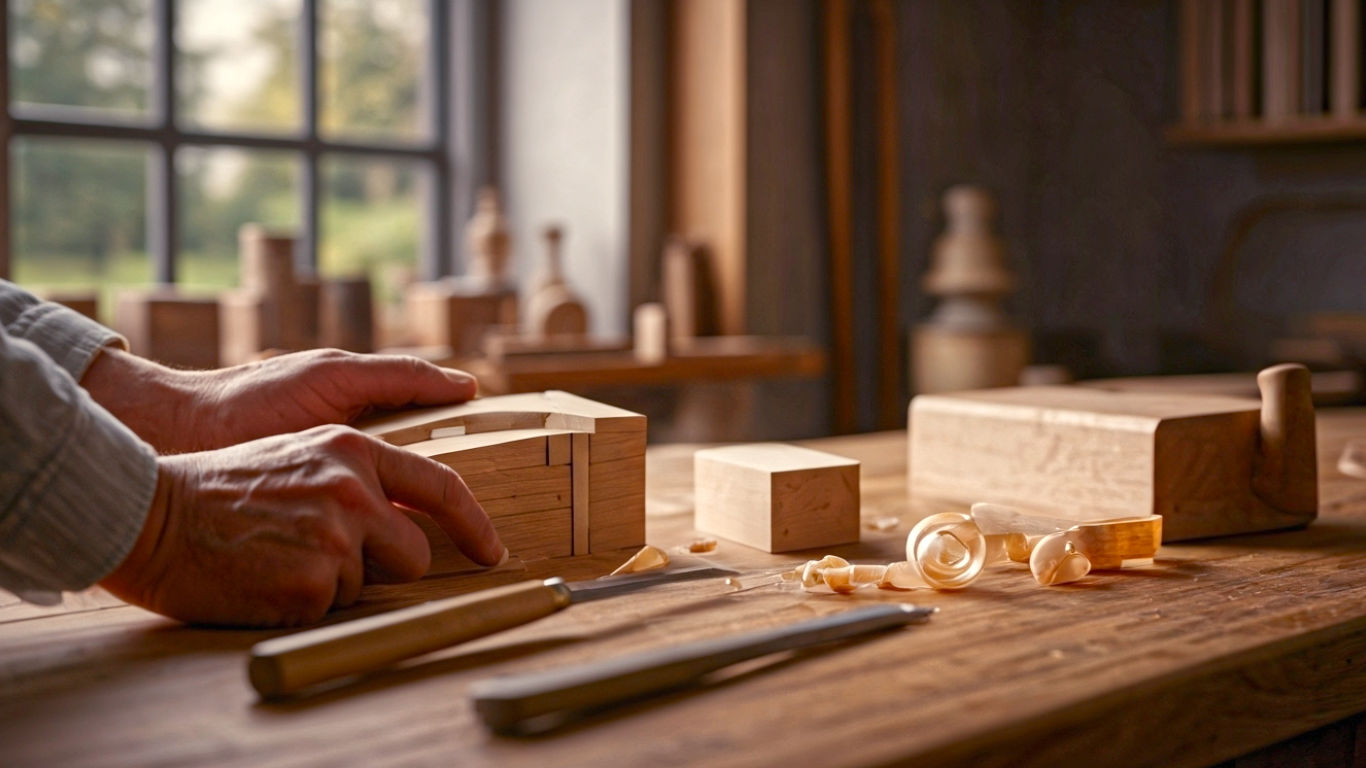The Silent Language of Wood: An Apprentice’s Guide to the Art of Japanese Woodworking
A comprehensive guide to Japanese woodworking, from its core principles of shokunin and wabi-sabi to the magic of nail-free joinery and its growing popularity in the UK.

This post may contain affiliate links. If you make a purchase through these links, we may earn a commission at no additional cost to you.
Step into a quiet workshop, away from the hustle and bustle of modern life. There’s no roar of power tools here, just the gentle shhh of a hand plane shaving a ribbon of wood as thin as paper. The air smells sweet, like cedar and pine. This is the world of Japanese woodworking, or mokkou. It’s more than just making things out of wood; it’s a conversation with nature that has been going on for over a thousand years.
For us here in Britain, with our own long history of craftsmanship—from Chippendale furniture to the timber frames of Tudor houses—there’s something deeply familiar yet wonderfully different about this Japanese art form. We understand the satisfaction of working with our hands, of taking a rough piece of timber and shaping it into something beautiful and useful. But Japanese woodworking takes this to another level. It’s a philosophy built on patience, precision, and a profound respect for the tree itself. It’s about creating things that are not only stunning to look at but are also designed to last for centuries, often without a single nail or screw.
This isn’t about rushing to the finish line. It’s about the journey. It’s about understanding the soul of the wood and working with it, not against it. Whether you’re a seasoned woodworker, a weekend DIY-er with a shed full of tools, or just someone who appreciates beautiful things, there’s a quiet wisdom in Japanese woodworking waiting to be discovered. So, let’s open the door to that workshop and begin.
The Heart of the Craft: Core Principles That Guide the Japanese Woodworker
Before we even pick up a tool, it’s vital to understand the ideas that shape every cut and every joint. Think of these principles not as strict rules, but as a mindset. They’re the invisible foundation upon which everything else is built.
Shokunin: More Than Just a Craftsman
In Britain, we might call someone a master carpenter or a skilled artisan. In Japan, the word is shokunin. This term goes much deeper. A shokunin is someone who has dedicated their life to mastering a craft. It’s not just a job; it’s a spiritual path. It’s about striving for perfection in your work every single day, not for fame or money, but for its own sake.
This mindset means that every task, no matter how small, is done with the utmost care. It’s about having a social and moral responsibility to create the very best work you possibly can. Imagine a chef who spends sixty years perfecting how to cook rice. That’s the spirit of shokunin. For the woodworker, it means sharpening tools to a mirror finish, making joints that fit so perfectly they seem invisible, and honouring the material they work with.
Wabi-Sabi: Finding Beauty in Imperfection
This is an idea that can feel a bit strange to our Western minds, which often chase after flawless, factory-perfect finishes. Wabi-sabi is a worldview centred on accepting that life is impermanent and imperfect. It finds beauty in things that are modest, humble, and unconventional.
In woodworking, this means you don’t throw away a piece of wood just because it has a knot or an interesting grain pattern. Instead, you celebrate it. That “flaw” tells a story of the tree’s life—the storms it weathered, the way it reached for the sun. A wabi-sabi piece might have a slightly uneven edge or a surface that shows the marks of the tool that shaped it. It’s a quiet beauty that grows on you over time, like a favourite old leather armchair or a worn stone step. It’s a reminder that true beauty isn’t about being perfect, but about being authentic.
“Use the Whole Tree”: A Deep Respect for Nature
In Japanese woodworking, nothing is wasted. This idea comes from a deep-seated respect for nature, rooted in Shinto and Buddhist beliefs. A tree that has taken decades, or even centuries, to grow is treated as a precious gift. The woodworker has a duty to use it wisely and respectfully.
This means the main trunk might be used for large beams or columns in a temple. The smaller branches could become legs for a stool. Even the offcuts and shavings aren’t just chucked in the bin. They might be used for smaller items like chopsticks, or even burned as fragrant incense. It’s a philosophy of sustainability that was practised long before it became a modern buzzword. The woodworker sees the life force, or ki, within the wood and aims to give it a new life in a different form.
A Journey Through Time: The History of Japanese Woodworking
The story of Japanese woodworking is the story of Japan itself. It has been shaped by earthquakes, influenced by religion, and perfected over centuries of quiet dedication. Unlike our own woodworking history, which was often driven by kings and queens wanting grand palaces, Japan’s craft was born from a need for resilience and a connection to the natural world.
The Dawn of an Art: Asuka and Nara Periods (538–794 AD)
The tale begins over 1,400 years ago, when Buddhism arrived in Japan from China and Korea. This was a game-changer. Suddenly, there was a need for huge, complex temple buildings to house statues of the Buddha. But Japan is a land of earthquakes and typhoons. Buildings needed to be strong, yet flexible.
This is where the genius of Japanese joinery, known as kigumi, was born. Craftsmen, called daiku, figured out how to join massive timber beams without nails or glue. They developed intricate, interlocking joints that could absorb the shock of an earthquake and allow the building to sway without collapsing. The Hōryū-ji temple in Nara, built in this period, is one of the oldest wooden buildings in the world. It’s still standing today, a testament to the incredible skill of these early masters.
Refinement and Elegance: The Heian Period (794–1185)
As Japanese culture moved away from Chinese influence and developed its own distinct style, so did its woodworking. This was an era of aristocrats and courtly life in Kyoto. The focus shifted from massive temples to more elegant, refined creations. Delicate screens with intricate latticework (kumiko), beautifully lacquered boxes, and graceful furniture were in high demand. Woodworkers began to specialise, honing their skills in specific areas. The tools also became more refined, allowing for greater precision and more delicate work.
The Age of the Samurai and Zen: Kamakura to Edo Periods (1185–1868)
This long period saw Japan ruled by samurai warriors. Their values of discipline, simplicity, and focus, influenced by Zen Buddhism, had a profound effect on the arts, including woodworking. The elaborate styles of the Heian court gave way to a more rustic, powerful aesthetic. This is when the tea ceremony became hugely important, and with it, the demand for simple, humble tea houses and utensils that embodied the spirit of wabi-sabi.
The Edo period, a time of peace lasting over 250 years, was a golden age for craftsmanship. With the cities growing, there was a huge demand for houses, furniture, and everyday objects. Guilds of craftsmen flourished, passing down their secret techniques from master to apprentice over many generations. It was during this time that the tools, techniques, and philosophy of Japanese woodworking were crystallised into the form we know today.
The Modern Era: Tradition Meets Technology
When Japan opened up to the West in the late 19th century, things began to change. Western tools and mass-production methods were introduced. For a while, it seemed like the old ways might be lost forever. However, a movement led by thinkers like Yanagi Sōetsu championed the beauty of traditional folk crafts, or mingei.
Today, Japanese woodworking exists in a fascinating balance between the ancient and the modern. While many woodworkers now use power tools for rough work, the final finishing and intricate joinery are almost always done by hand. There is a new generation of shokunin, both in Japan and around the world (including here in the UK), who are dedicated to preserving these ancient skills while also innovating and creating new designs.
The Japanese Toolbox: A Symphony of Steel and Wood
If you were to peek inside a Japanese woodworker’s toolbox, it might look a bit different from a typical British one. There are no chunky jack planes or heavy mallets. Instead, you’ll find a set of elegant, minimalist tools, each designed to perform its task with incredible efficiency and precision. The key difference? Most Japanese tools are designed to cut on the pull stroke, not the push stroke. This might seem odd at first, but it offers a huge amount of control.
The Japanese Saw (Nokogiri)
This is often the first tool that people notice. A Japanese saw has a very thin, flexible blade with razor-sharp teeth. Because it cuts on the pull, the blade is under tension, which means it can be much thinner than a Western push saw.
- Simplified Explanation: A Japanese saw is like cutting with a sharp knife instead of pushing a blunt wedge through the wood. Pulling the thin blade keeps it straight, giving you a very clean, precise cut with much less effort.
- Detailed Explanation: There are several types of nokogiri. The Ryoba is a great all-rounder, with sharp cross-cutting teeth on one edge and coarser rip-cutting teeth on the other. The Dozuki has a rigid spine along its back, which makes it perfect for cutting delicate joints like dovetails with pinpoint accuracy. The teeth are incredibly fine, leaving a surface that often needs no sanding.
The Japanese Plane (Kanna)
The kanna is not a heavy metal beast like our Stanley or Bailey planes. It’s a simple block of Japanese white or red oak with a fearsomely sharp blade bedded in it. There are no complex screws for adjusting the blade; instead, it’s all done with tiny taps from a small hammer.
- Simplified Explanation: Think of the kanna as a precision shaver for wood. It peels off shavings so thin you can read a newspaper through them, leaving behind a surface that’s as smooth as glass, far smoother than any sandpaper could achieve.
- Detailed Explanation: Setting up a kanna is an art form in itself. The craftsman spends hours flattening the sole and fitting the blade perfectly. A well-tuned plane can create a finish so glossy it looks like it’s been varnished. Using a kanna is a full-body motion, a dance between the user and the wood.
The Japanese Chisel (Nomi)
Japanese chisels are masterpieces of the blacksmith’s art. They are made from two layers of steel: a very hard, brittle layer for the cutting edge, forge-welded to a softer, tougher layer for the body. This combination creates an edge that can be sharpened to an unbelievable degree while still being strong enough to withstand mallet blows.
- Simplified Explanation: A nomi is like a surgeon’s scalpel for wood. Its incredibly sharp edge allows you to carve out precise joints and shapes with complete control.
- Detailed Explanation: The back of a Japanese chisel is hollow-ground, which makes it much easier to flatten and sharpen the cutting edge. They come in a huge range of shapes and sizes, from heavy-duty bench chisels (oire nomi) to delicate paring chisels designed for the finest adjustments.
Sharpening Stones (Toishi)
In Japanese woodworking, sharpness is everything. A dull tool is considered dangerous and disrespectful to the wood. The secret to this incredible sharpness lies in Japanese waterstones, or toishi. These are synthetic or natural stones that use water as a lubricant. Craftsmen use a series of stones with progressively finer grits, starting with a coarse stone to shape the edge and moving up to an ultra-fine stone that polishes it to a mirror finish. The process is meditative, a ritual performed at the start of every day in the workshop.
The Magic of Joinery: Building Without Nails
This is where the true genius of Japanese woodworking shines through. For centuries, Japanese craftsmen have been building everything from small boxes to towering pagodas using nothing but interlocking wooden joints (kigumi). These joints are not just functional; they are incredibly beautiful, often becoming a decorative feature of the piece.
Why No Nails?
There were several reasons for this. Firstly, high-quality iron was expensive and scarce in ancient Japan. Secondly, and more importantly, nails and screws can rust and loosen over time, especially in a damp climate. A well-made wooden joint, on the other hand, can actually tighten over the years as the wood settles, and it can be taken apart for repairs if needed. But the main reason is philosophical: a metal fastener is seen as an intrusion, a foreign object that violates the purity of the wood. A kigumi joint is a partnership between two pieces of wood.
A World of Interlocking Puzzles
There are hundreds, if not thousands, of different Japanese joints, each with a specific purpose. Some are simple, while others are so complex they look like impossible puzzles.
- Dovetail Joints (Ari Gata): We have dovetails in Western woodworking too, but the Japanese have taken them to an artistic level. They often use intricate variations, like the “sunrise” dovetail, which radiates out like the rays of the sun. These are used for making strong and beautiful corners on boxes and drawers.
- Mortise and Tenon Joints (Hozo): This is the workhorse joint, used to join pieces of wood at a right angle, like a table leg to its apron. Japanese craftsmen have developed countless variations, including “through” tenons that pass all the way through the other piece and are secured with a small wedge, creating a strong mechanical lock.
- Scarf Joints (Tsugite): What if you need a beam that’s longer than the tree you’re using? You join two pieces together end-to-end using a scarf joint. These can be incredibly complex, with interlocking fingers and keys that make the joined piece just as strong, if not stronger, than a single piece of timber. A famous example is the kanawa tsugi, a joint so clever it can be assembled and disassembled with just a single wooden pin.
The precision required to cut these joints by hand is breathtaking. There is no room for error. Each cut must be perfect. When the two pieces slide together, the fit is so snug that it creates a satisfying sigh as the air is pushed out. It’s a moment of quiet magic.
From Forest to Furniture: The Process Step-by-Step
So, how does a rough log from the forest become a beautiful, finished piece? The process is slow, deliberate, and deeply connected to the seasons.
1. Selecting and Drying the Timber
The journey begins with choosing the right tree. A master craftsman can look at a standing tree and know exactly how the grain will look and how the wood will behave. Traditional woods include Japanese cypress (hinoki), which is prized for its fragrance and durability, cedar (sugi), which is light and beautiful, and zelkova (keyaki), a hardwood with a dramatic grain similar to our English elm.
Once the tree is felled, it’s not just cut up and used straight away. The wood needs to be dried very slowly, often for years. This process, known as air-drying, allows the moisture to leave the wood gradually, which prevents it from warping and cracking. The craftsman gets to know each board, watching how it moves and settles over the seasons, planning its future use.
2. Marking Out (Sumi-tsuke)
Before any cutting begins, the pieces are carefully marked out. This isn’t done with a pencil. Instead, Japanese woodworkers use a special square (sashigane), a marking knife (shirabiki), and ink (sumi). The knife severs the wood fibres, creating a razor-sharp line that the saw or chisel can follow perfectly. This ensures a level of accuracy that a thick pencil line could never achieve.
3. Cutting the Joints
This is the heart of the process. Using saws, chisels, and incredible skill, the craftsman cuts the male and female parts of each joint. It’s a process of constant checking and re-checking. A thousandth of an inch can be the difference between a perfect fit and a sloppy one. There’s no wood filler to hide mistakes here!
4. Assembly (Kumi-tate)
This is the moment of truth. The carefully cut pieces are brought together. Sometimes, a wooden mallet (genno) is used to gently persuade the joints to slide home. There’s no glue in many traditional pieces, especially in architecture. The sheer precision of the joinery is enough to hold everything together for centuries. For furniture, a natural rice-based glue might be used, but the strength still comes from the mechanical lock of the joint itself.
5. The Final Finish
You might be surprised to learn that many pieces of Japanese woodworking aren’t finished with heavy varnishes or lacquers. The goal is to celebrate the natural beauty of the wood, not cover it up. The final step is often to plane the surface with a super-sharp kanna. This creates a finish that is incredibly smooth to the touch and has a deep, lustrous sheen that reflects the light. Sometimes, natural oils like tung oil or persimmon tannin are used to protect the wood and bring out the colour of the grain.
Japanese Woodworking in Britain Today
For a long time, the world of Japanese woodworking felt very distant and mysterious. But in recent years, something wonderful has happened. Thanks to the internet, books, and a growing appreciation for craftsmanship, these techniques are finding a new home here in the UK.
There are now dedicated workshops and courses across the country where you can learn the basics, from sharpening a chisel to cutting your first dovetail joint. British woodworkers are discovering the joy of using Japanese tools, appreciating their precision and ergonomic design. You can even see the influence of Japanese aesthetics in modern British furniture design—a focus on clean lines, natural materials, and minimalist beauty.
For the home DIY enthusiast, getting started doesn’t mean you have to throw out all your Western tools. A good quality Japanese Ryoba saw is a fantastic addition to any toolbox and can make cutting wood a real pleasure. Learning to sharpen your tools on waterstones, even your regular chisels and planes, can completely transform your woodworking experience.
It’s about adopting the mindset. It’s about slowing down, focusing on the task at hand, and finding satisfaction in doing something well. It’s a perfect antidote to our fast-paced, disposable culture.
The Enduring Legacy: Why It Still Matters
In a world of flat-pack furniture and mass-produced goods, why should we care about an ancient craft from the other side of the world? Because Japanese woodworking teaches us lessons that are more relevant today than ever before.
It teaches us about sustainability—about using natural resources with respect and avoiding waste. It teaches us about patience—the value of taking our time to do something properly. It teaches us about mindfulness—of being fully present in our work and finding a sense of calm and focus. And it teaches us that true beauty often lies in simplicity, authenticity, and the quiet story told by a humble piece of wood.
The silent language of wood speaks to a universal human desire to create, to connect with nature, and to leave behind something of lasting value. And that’s a language we can all understand, whether we’re in a workshop in Kyoto or a garden shed in Kent.
Further Reading & Resources
For those wishing to delve deeper, these resources are highly respected within the woodworking community:
- Japan Woodworker: A fantastic resource for authentic Japanese tools and educational content.
- The Japan Society (UK): Often hosts events and lectures related to Japanese arts and crafts, providing cultural context.
- Hida Tool & Hardware Co.: While US-based, their website is an encyclopaedia of information on Japanese tools and their uses.
- “Japanese Woodworking Tools: Their Tradition, Spirit and Use” by Toshio Odate: Considered the bible for anyone serious about understanding the craft. Odate was a shokunin who trained in Japan and his book is a beautiful blend of practical instruction and philosophical insight.

















